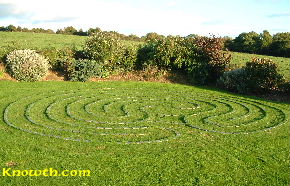Labyrinths
 The Greeks were building labyrinths
over 3,000 years ago, in a form we now call the Classical seven
circuit design. The labyrinth design which brings the walker to the
centre through a single path may well have evolved from a basic spiral
design the archetypal symbol known to many ancient cultures.
The Greeks were building labyrinths
over 3,000 years ago, in a form we now call the Classical seven
circuit design. The labyrinth design which brings the walker to the
centre through a single path may well have evolved from a basic spiral
design the archetypal symbol known to many ancient cultures.
The spirals carved into the entrance stone at Newgrange over 5,000 years ago have a similar feel to a labyrinth.
 Garden labyrinth near the ancient
passage mound at Fourknocks, based on the
classical 7 circuit design. The centre of the labyrinth has been modified so that there
are no straight lines, like the entrance stone at Newgrange.
Garden labyrinth near the ancient
passage mound at Fourknocks, based on the
classical 7 circuit design. The centre of the labyrinth has been modified so that there
are no straight lines, like the entrance stone at Newgrange.Labyrinths have been constructed in churches, hospitals, and parks. These are often used for contemplation; walking among the turnings, one loses track of direction and of the outside world, and thus quiets the mind.
 Quadruple Labyrinth
Quadruple LabyrinthRecently constructed archetypal Energies Quadruple Labyrinth, at the Labyrinth Center for Peace & Reconciliation, Glore Mill Follain Art Center, Kiltimagh, Co. Mayo, Ireland.
 Box hedge and grass Labyrinth at An Tobar retreat house in Ardbraccan, Co. Meath.
Box hedge and grass Labyrinth at An Tobar retreat house in Ardbraccan, Co. Meath.
In 1988 Fr. Michael Kane, director of An Tobar, had taken a training course at Grace Cathedral, San Francisco and on his return, with the help of Martin Dier had created a Cretan labyrinth in the grounds, using box hedges.
 Chartres
Labyrinth replica at the Anglican Cathedral
Liverpool. The canvas 11 circuit Chartres replica Labyrinth was laid out
at the Cathedral by Sarah Harrison and Eileen Wiggins.
Chartres
Labyrinth replica at the Anglican Cathedral
Liverpool. The canvas 11 circuit Chartres replica Labyrinth was laid out
at the Cathedral by Sarah Harrison and Eileen Wiggins.
Labyrinth Links
- The Labyrinth Society - based in the USA, members worldwide.
- Labyrinth Locator - worldwide database of labyrinths.
- Labyrinths from Wikipedia (free encyclopaedia).
- Labyrinths from the Mid-Atlantic Geomancy site.
Boyne Valley Private Day Tour
 Immerse yourself in the rich heritage and culture of the Boyne Valley with our full-day private tours.
Visit Newgrange World Heritage site, explore the Hill of Slane, where Saint Patrick famously lit the Paschal fire.
Discover the Hill of Tara, the ancient seat of power for the High Kings of Ireland.
Book Now
Immerse yourself in the rich heritage and culture of the Boyne Valley with our full-day private tours.
Visit Newgrange World Heritage site, explore the Hill of Slane, where Saint Patrick famously lit the Paschal fire.
Discover the Hill of Tara, the ancient seat of power for the High Kings of Ireland.
Book Now
Home
| Newgrange
| Knowth
| Dowth
| Hill of Tara
| Fourknocks
| Loughcrew
| More Places
| Labyrinths
| Local Info
| Art Works
| Articles
| Images
| Books
| Links
| Boyne Valley Tours
| Contact
